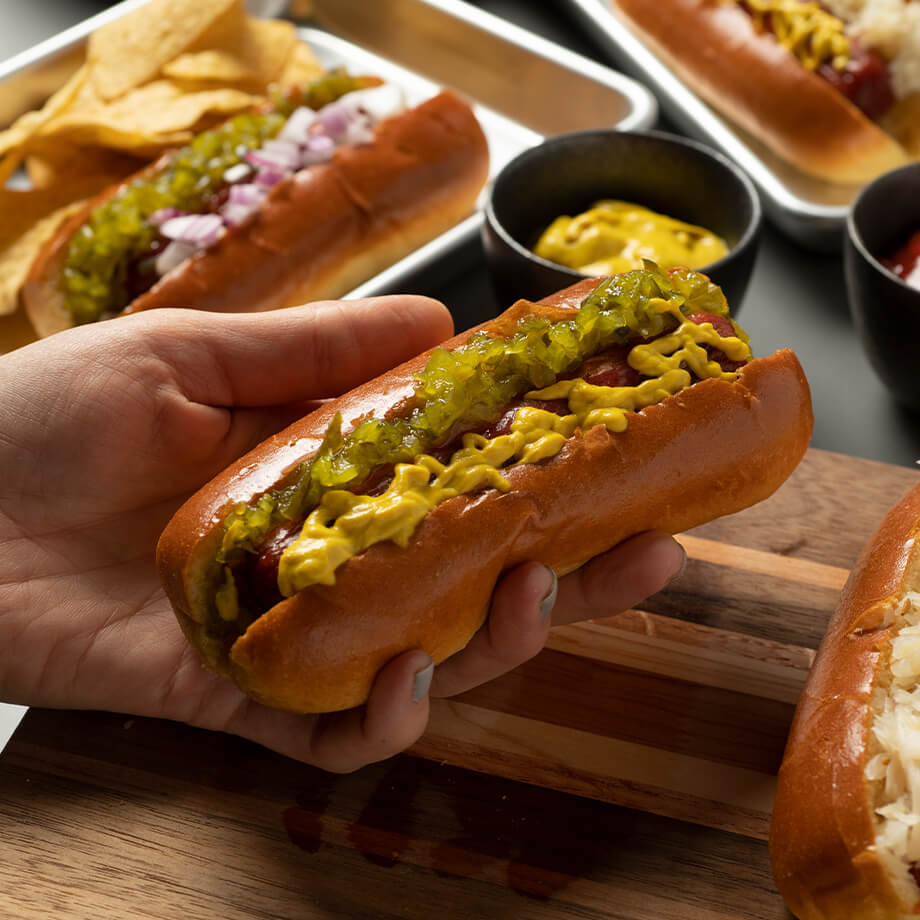Hot dogs are delicious, inexpensive, and easily prepared within 5-10 minutes! They’re an equally perfect choice when you need to feed a large, hungry crowd during the summer holidays or come up with a quick, yet satiating weeknight meal for your family.
But not all hot dogs are created equal—some contain artificial ingredients, preservatives, and multiple proteins, while others are all-natural and all beef, with no binders or fillers. So how do you know if a hot dog is considered “good” to eat?
If you want to know more about hot dogs, you’re in the right place. We’re going to explore what hot dogs are made of, how exactly they’re made, and how to spot a high-quality hot dog at the grocery store so you can meal prep with confidence!
What Are Hot Dogs Made Of?
Some hot dogs are made of only three ingredients: beef trimmings, salt, and seasonings. However, many hot dogs can also contain fillers, preservatives, and other artificial additives.
Along with considering what hot dogs are made of, you should also consider the quality of the ingredients.
BEEF TRIMMINGS AND OTHER MEAT
Beef trimmings are excess pieces of beef made when meat producers create cuts of beef such as steak, ribs, or brisket. These trimmings are the same quality as the rest of the meat, but they are not sold in this form due to their non-uniform size. However, these pieces work great as ingredients in hot dogs. Using beef trimmings reduces food waste because it finds a purpose for all the meat used from an animal. This puts less stress on the environment, as meat producers can create more products using fewer animals.
It’s important to know that while other commercial brands use low-quality ingredients, Coleman Natural gets its beef trimmings from the highest quality cuts of meat possible. All trimmings are purchased from small American family farmers who raise their livestock humanely and without the use of antibiotics or added hormones.
SALT AND SEASONINGS
Hot dogs are flavored using salt and seasonings, such as paprika, garlic, onion, mustard, coriander, and mace spices. In addition to these seasonings, hot dogs can contain sweeteners. At Coleman Natural, we only use natural sweeteners like cane sugar and honey instead of artificial sweeteners like high-fructose corn syrup.
Our hot dogs are also uncured, which means we don’t add nitrates or nitrites to preserve them. Instead, we use all-natural cultured celery powder and sea salt to cure our hot dogs. Curing draws moisture from meat to extend its life and ward off bacteria.
FILLERS, BINDERS, AND PRESERVATIVES
As mentioned above, the quality of ingredients in hot dogs can vary drastically. Therefore, you should read ingredient lists carefully, noting any alternate proteins, fillers, or artificial ingredients. You can find information about the quality of the product on the packaging label or through a brand’s website.
Two things to watch out for when reading ingredients are fillers and binders. While the USDA prohibits hot dogs from containing more than 3.5% non-meat binders, companies can still use ingredients such as cornstarch, or even dry milk powder, which can be more susceptible to contamination. They may also use artificial preservatives and colorants including sodium erythorbate, sodium propionate, and sodium phosphate.
Coleman Natural doesn’t use fillers to stretch our beef hot dogs, and we never use artificial preservatives. Instead, we only use all-natural meat and always remain transparent about any other added ingredients, like sea salt and honey.

How Are Hot Dogs Made?
There are many steps involved in hot dog production. Not only are hot dogs seasoned and shaped but they are also fully cooked by the time they hit shelves for consumers to purchase.
Here is the basic process of making hot dogs:
- Beef trimmings are ground to reduce their size.
- Seasonings, salt, and water are added.
- The combined ingredients go through a second blend to produce an ultra-fine grind.
- The mixture is stuffed into a plant-derived casing made of cellulose. Some hot dogs are stuffed into casings made from animal intestines. Animal casings usually remain on hot dogs after they are finished cooking, and cellulose casings are removed.
- The hot dog is smoked in its casing in a large oven. Hot dogs may be wood smoked or liquid smoked.
- The casing (if cellulose-based) is removed, and the fully-cooked hot dogs are packaged and sent to retailers.
Understanding the Difference Between the Good and the Bad
When looking for hot dogs, take the time to really understand the ingredients on the label.
Look out for fillers used to bulk up hot dogs, and binders used to hold ingredients together. If you don’t recognize an ingredient, it may be one of these additives.
Another way to identify high-quality hot dogs is by their appearance. All of the hot dogs in a package should be uniform in color, but this color may not be the same across brands. Some brands of hot dogs can look lighter or darker than others, and this typically is an indicator of smoke level, not quality (darker hot dogs are often smokier).
“Great hot dogs contain high-quality, simple ingredients. You should be able to see where the meat comes from – Coleman Natural provides this information on its product labels – and recognize the ingredients that are used. Unfamiliar chemicals and alternate proteins in the mix are a red flag.”
Robert McEwan, Senior Food Technologist for Perdue Farms (parent company of Coleman Natural Foods)
The Coleman Way
Since our start in 1875, we’ve made it our mission to only work with independent family farmers in the U.S. This means that our labels will always indicate “Raised in the USA.” Our meat is sourced from animals born and raised in the United States, which is important for conscious consumers who want to support the domestic economy.
Also, as part of our values, we always prioritize animal welfare and crate-free practices—meeting American Humane Certified™ standards for our pork products and redefining what all-natural means.
“What we do takes a lot of animal husbandry, or care for the animals. We keep an eye on them, we know them, and it results in happier pigs and overall better meat.”
Tim Brandt, Manager at Brandt Swine Farms
The Benefits of All-Beef Hot Dogs
All-beef hot dogs aren’t only better for you and your family, but they also taste more appetizing because they’re made with high-quality beef and natural seasonings. And since all of the beef used in Coleman Natural products is raised without antibiotics and added hormones, you can feel a sense of comfort feeding our all-natural hot dogs to your family.
Whether you’re grilling hot dogs for a backyard party or cooking them as part of an easy meal like the Deconstructed Chicago Dog Salad, all-natural beef hot dogs are always your best bet.
If you enjoyed this article, read these next:
- What are Uncured Dogs and Are They Healthy?
- Can You Eat Hot Dogs While on a Keto Diet?
- How Long Do Hot Dogs Last?
This article was originally published on August 8, 2022, and has since been updated.


